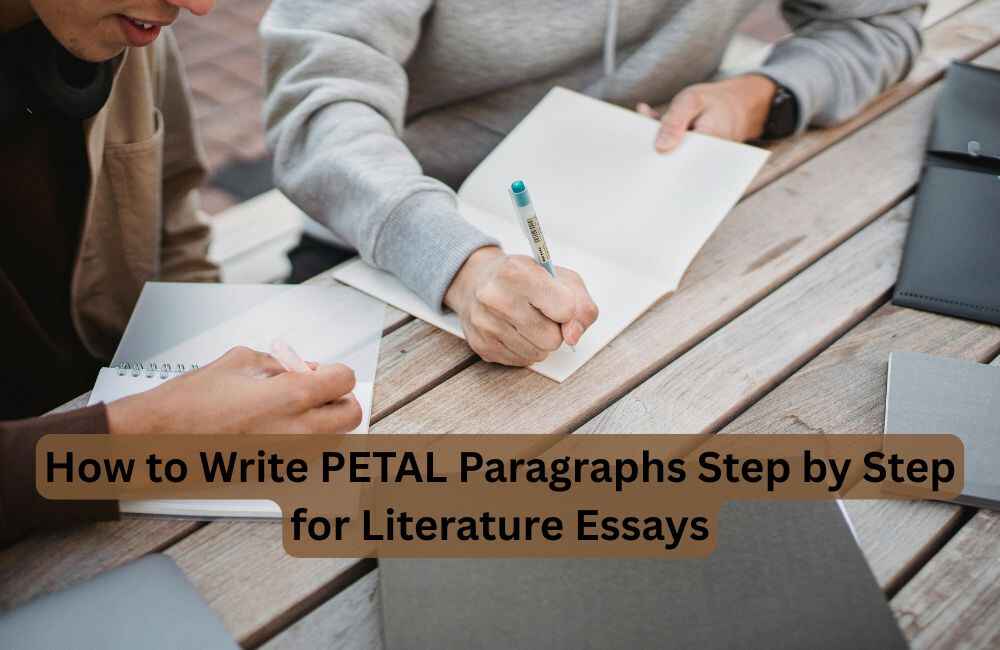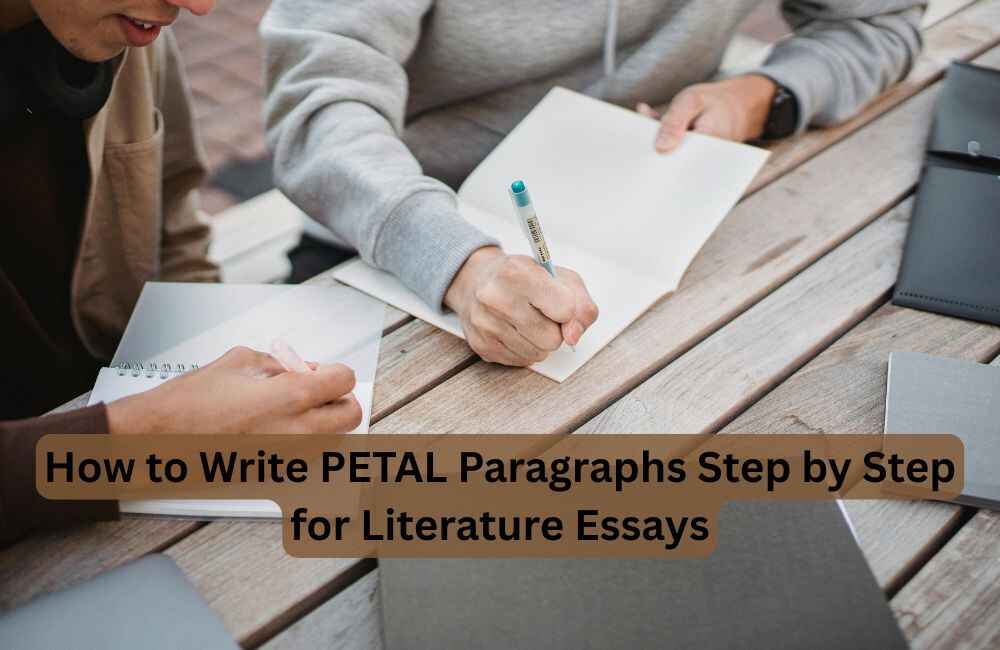How to Write PETAL Paragraphs Step by Step for Literature Essays

Writing literature essays at university may at times seem like walking through a maze, so much effort, yet no sense of direction. You may spend hours scribbling down novels or poetry, but when you finally sit down to write, the paragraphs are all confused and examiners usually say that your ideas “lack structure.” In fact, a 2024 survey by the Higher Education Policy Institute (HEPI) revealed that 62% of UK undergraduates admitted struggling most with essay organisation, even more than with research or referencing.
The petal paragraphs method makes life easier. It’s a systematic method of building paragraphs with effortless incorporation of ideas, quotes, and analysis. In this blog, we’ll explain what is a petal paragraphs, show you how the petal structure works step by step, highlight common mistakes, and share practical examples. With using assignment help experts and constant practice, the PETAL paragraphs technique can make essay writing a master skill from a challenging task.
Why Students Fail with Literature Essays
For the majority of UK students, literary essays are a constant battle between creativity and structure. You will have great ideas on a text, but when attempting to write them down in writing, the paragraphs repeat information, run on without analysis, or have no discernible connection to the essay question.
The following are the common issues faced:
Essay questions, like “Discuss the representation of identity in post-war British literature” can seem too vague and overwhelming.
Scattered analysis – Students often insert quotes without fully unpacking their meaning.
Inadequate scores despite exertion – Notwithstanding extensive reading, research, and drafting, essays may receive diminished marks due to a deficiency in logical coherence.
A 2023 report by the Office for Students discovered that more than half of UK undergraduates are not essay-ready upon arrival at university, and essay structure is the most frequent cause of lower-than-anticipated grades.
This is the reason why tools such as PETAL is being incorporated into A-Level and university classrooms across the country. The petal framework remains organized for you, with every paragraph directly responding to the essay question and demonstrating analytical acumen. For UK students balancing coursework, part-time jobs, and deadlines, a dependable paragraph-construction tool can make the difference between mediocre and outstanding work.
The Role of PETAL Paragraphs in Essay Writing
So, what is a petal paragraph help? It’s a structured approach aimed at simplifying the essay process, particularly in topics such as English Literature, where examiners are looking for specificity and close analysis. The PETAL acronym represents Point, Evidence, Technique, Analysis, and Link. Each has a specific function:
- Point: Your main argument in the paragraph.
- Evidence: A quotation or example from the text.
- Technique: The literary device used (like imagery, irony, or symbolism).
- Analysis: How this supports your point and the essay question.
- Link: A final tie back to the question or the essay’s wider argument.
This format ensures paragraphs are short and avoids students from going off on tangents into summary or repetition. Based on a report by UK examiners in 2024, the essays that employed structured paragraphs such as PETAL were “clearer, more focused, and easier to mark positively” than unstructured answers.
Alongside exam technique, PETAL also reduces stress. Rather than wondering “What do I write next?”, you always do. Assignment experts recommend PETAL as a technique not just for beginners but for experienced authors who need to strengthen their framework. Whether working with Shakespeare, Orwell, or contemporary poetry, PETAL paragraphs help you put ideas in a coherent order, and that’s exactly what gets marks in UK universities.
Breaking Down PETAL Paragraphs Step by Step
Let’s divide PETAL paragraphs into smaller segments with an example. For example, if the question is: How does Shakespeare present ambition in Macbeth?”
- Point: Begin with a clear claim. “Shakespeare portrays Lady Macbeth as dangerously ambitious through her manipulative nature.”
- Evidence: Back it up with a quotation. “Look like the innocent flower, but be the serpent under’t.”
- Technique: Spot the literary device. Here, Shakespeare uses a metaphor.
- Analysis: Explain how it works. “The metaphor highlights Lady Macbeth’s duplicity, as she conceals ambition under an innocent façade. This suggests her willingness to corrupt appearances for power.”
- Link: Tie back to the question. “This reflects the destructive consequences of unchecked ambition, central to Macbeth’s downfall.”
Why does this matter? Because many students stop after providing evidence. They will quote Lady Macbeth, say “this shows ambition,” and off they go. But examiners need more depth: why does Shakespeare employ this method? How does this relate to the theme?
According to Ofqual’s 2024 assessment framework, essays with clear explanation of writer’s strategies score much better analysis marks. Looking at the petal structure, you ensure that nothing is missing, you’ve got the claim, evidence, and explanation all in the package.
The best part? Once you practice a few times, PETAL paragraphs becomes second nature, and you’ll naturally start building stronger, examiner-friendly paragraphs.
PETAL Paragraphs in Action: A Sample Walkthrough
To make this practical, let’s apply PETAL paragraphs to a different text: George Orwell’s 1984. Question: “How does Orwell present control in society?”
- Point: Orwell shows that language is used as a tool of control.
- Evidence: “Newspeak was designed not to extend but to diminish the range of thought.”
- Technique: Orwell uses irony, language, which normally enables expression, instead restricts it.
- Analysis: This demonstrates how the Party eliminates freedom by reducing thought itself. By narrowing language, they erase rebellion before it can exist. This chilling manipulation shows the extent of totalitarian control.
- Link: Thus, Orwell uses language not just as a theme but as a method of showing society’s complete subjugation.
Observe how every step is crucial. Without technique, you’d be quoting. Without analysis, you’d be paraphrasing. Without a connection, the examiner would say, “So what?”
A 2024 survey by Times Higher Education revealed that UK students who used structured methods like PETAL were 30% more likely to achieve higher essay grades in English and humanities subjects. Why? Because examiners reward clarity, and PETAL paragraphs give them exactly that.
Using petal paragraphs sentence starters like “This suggests…” or “This highlights…”s can make the analysis step easier for students. These simple methods ensure paragraphs are sharp, concise, and easy to evaluate.
Where Students Go Wrong with PETAL
Even though PETAL seems easy, students misuse it. Some common errors are:
Insufficient Evidence: Quoting very concise or vague wording that does not have substantive content.
General Strategies: Simply saying “this is imagery” without naming metaphor, simile, or personification.
Shallow Analysis: The observation repeated without a description of how. For instance, “This shows ambition” without describing how.
Incomplete Connection: Not connecting back to the essay question, hence an incomplete paragraph.
For example, writing “Lady Macbeth is ambitious. Shakespeare uses a metaphor. This shows ambition.” is technically PETAL but fails to add depth. Examiners prefer essays to consider things, rather than tick boxes.
The UK Quality Assurance Agency (QAA) in its 2024 report observes that essays with poor links to the question are marked low even with good analysis. This goes to show just how important the “L” in PETAL actually is.
Double check everything to avoid errors: Have I clarified the significance of my evidence? Have I connected it back to the essay question? PETAL is more effective as a flow than as a checklist.
This is where you need feedback. Students who seek assistance from online assignment help typically catch these mistakes earlier, and hence, have tighter and more persuasive PETAL paragraphs.
How to Improve PETAL Paragraphs Without Overthinking
Worried that PETAL will make your essays robotic? With some adjustments, your paragraphs can be interesting and natural but still organized.
Here’s how to improve:
- Use short, targeted quotes: Long quotations interrupt flow and can confuse readers.
- Vary sentence starters: Instead of always using “This shows…,” try “This suggests…,” “This highlights…,” or “This reveals…” for variety.
- Go for depth: It’s better to fully explore one technique than skim three. Quality beats quantity.
- Practice with exam questions: Many UK universities publish past papers. Applying PETAL to them helps make the method second nature.
- Seek feedback: Getting comments from tutors, peers, or assignment experts helps refine your analysis.
According to a 2025 UCAS survey, students who practiced paragraph structures weekly improved their essay grades by 22% over a term. Consistency matters.
If you’re feeling stuck, there’s no harm in reaching for help. Students tend to search “help me with assignment” when faced with numerous deadlines. Through interactions with writing essay services or peer assistance, you will discover where to stretch analysis and where to eliminate unnecessary words, making PETAL from a mechanical task to a refined, natural writing practice.
When PETAL Isn’t Enough: Getting Extra Help
Even with practice, PETAL won’t solve every essay challenge. You may still have problems with overall structure, proofreading, or coping with multiple deadlines. Sometimes, the problem is not with the method but with coping with part-time work, societies, and university workloads, something with which many UK students are all too familiar.
For this purpose, Uni Assignment Helper proves to be highly beneficial. Being a top online assignment help provider, we specialize in helping UK students with essay composition exercises. Whether you desire in-depth feedback on PETAL paragraphs, proofreading for better clarity, or end-to-end support from assignemnt experts, our assistance is dedicated to making your writing academically sound.
We’ve had thousands of students contact us and say, “I just need someone to assist me in planning assignments.” With our writing essay services, we offer step-by-step assistance specific to your essay questions and university marking schemes.
The benefit? You’re not only submitting stronger essays but also learning how to improve your own writing. Over time, PETAL and other structures become second nature, and you’ll feel more confident tackling any essay challenge.
If you’re in doubt, remember, getting help isn’t a weakness. It’s a smart way to ensure your ideas shine, especially when UK universities place such high emphasis on structure and clarity.
Conclusion: Practice + Guidance Makes PETAL Easy
The PETAL paragraphs structure is the simplest yet most effective method of writing literature essays. Through the process of Point, Evidence, Technique, Analysis, and Link, this style ensures that your arguments are structured and persuasive. At first, it may feel like a formula, but with practice, PETAL becomes an effortless habit, something that strengthens your writing rather than restricts it.
Recent UK statistics indicate that students using systematic paragraphing techniques such as PETAL consistently score higher in essay tests. And don’t forget, the more you practice, the more natural it becomes.
But practice alone isn’t always enough. With expert support from University Assignment Helper, you can refine your writing, catch common mistakes, and get personalised guidance from professional assignment help experts. Whether you’re tackling Shakespeare, Orwell, or modern British poetry, PETAL plus guidance is your best formula for essay success.
Ready to boost your grades? Contact Uni Assignment Helper today and let our assignment experts guide you every step of the way.
Our Latest Post
Stay updated with our latest tips, guides, and insights – fresh from the blog!





